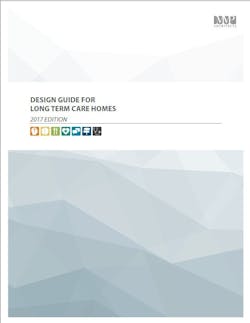Introduction
In continuing education, “death by PowerPoint” has unfortunately become an expression that I hear too often at conferences, as colleagues are seeking to find out about trends, tools, and new advancements in healthcare design. New venues, different ways to learn, and alternative formats are of interest to the design community, but can also make an impact on other players in healthcare—such as providers and regulators.
Behind the Scenes
JSR went behind the scenes, as the Facility Guidelines Institute (FGI) filmed the first segment of its new continuing education format, “Residential Care Guidelines: A Provider, Designer, and Regulator Perspective.” The new program features “Guidelines for Design and Construction of Residential Health, Care, and Support Facilities” (“the Guidelines”) and was recently filmed at Garden Spot Village, located in New Holland, Pa.
The finished product will include music, interviews, dialogue, and images to provide an experiential educational opportunity. The program, sponsored by Mannington Commercial, is creating not only a continuing education session for design professionals, but is also being developed to assist long-term care providers to foster an understanding of the importance of adopting the Guidelines throughout the U.S. As indicated by Doug Erickson, CEO of FGI, the development of this program is meant to assist in educating state regulators, providers, and designers on the availability of the Residential Care Guidelines in hopes of having a go-to resource that will support person-centered care settings that have consistent criteria.
In furthering the discussion on the importance of adopting the Guidelines, Steve Lindsey, CEO of the innovative Garden Spot Village, encourages providers to sit up and take notice on how the Guidelines can support the return on investment of their communities. For example, if better work environments can reduce staff turnover, there is an opportunity to save money. Researchers indicate that each employee that is replaced costs an organization up to 30 percent of their annual salary, not to mention the negative impact created for the resident by the lack of continuity in care. Turnover costs are comprised of both direct and indirect costs and, according to one comparative review of nurse turnover rates published in 2014, the costs in the U.S. per nursing staff turnover is $20,561 (Duffield C. M., Roche, M.A., Homer, C., Buchan J. & Dimitrelis S. [2014]. A comparative review of nurse turnover rates and costs across countries. “Journal of Advanced Nursing” 70(12), 2703-2712. doi: 10.111/jan.12483)
Charlie Schlegel, director of the Pennsylvania Department of Health within the Division of Safety Inspection, provided a regulator’s perspective and concluded that the Guidelines provide criteria for creative models and innovation in the long-term care market place. The provision of guidance on non-licensed settings also demonstrates the importance of including information on the full continuum of care, including independent living, outpatient rehabilitation, and wellness centers. Schlegel also focused on the importance of the functional programming process that includes environment of care considerations and the outcomes of the resident safety risk assessment. Understanding the operational requirements to implement a care model leads to the design of a supportive environment for the end users. From the Authority Having Jurisdiction (AHJ) perspective, the narrative that the Guidelines require needs to support the plan that is shown to the regulator for approval. The alignment between the two can also act as valuable “checks and balances” for the design professional prior to submitting plans for review, improving the rate of success of the submission.
As one of the tri-chairs for the Guidelines, I was utilized as the design representative for the discussion. The Guidelines support the design and development of person-centered environments in all types of settings: residential health facilities, which include nursing homes and hospice facilities; residential care and support facilities, which include assisted living facilities and independent living settings; and non-residential care and support facilities, which includes adult day care, and outpatient rehabilitation and wellness centers. For the 2018 Guidelines, two new settings have been added: settings for individuals with intellectual and/or developmental disabilities and long-term residential substance abuse treatment facilities. Design professionals are utilizing the Guidelines, but can also promote the Guidelines to their clients and AHJs. The goal is for the provider community to support legislation that supports the adoption of the person-centered Guidelines; as design professionals, we are in the perfect role to encourage our provider clients to work on adoption with their colleagues in each state. Ultimately, person-centered settings are the “tipping point” that we are looking to achieve for residential health, care, and support facilities to improve the lives of residents, families, and staff.
Healthcare Designer Profile
Robert Wrublowsky, principal architect, MMP Architects
Dynamic Guidelines: Embracing Continual Collaboration
Robert Wrublowsky is a remarkable architect who has created the “Design Guide for Long Term Care Homes,” which includes Guiding Principles and provides a comparison of Institutional Models to Small House Models. The Guide includes an evidence-based design (EBD) research topic, uses icons to provide the associated outcomes, features an explanation of the design issue that the research topic addresses, and discusses EBD interventions along with the rationale applicable to the intervention based upon a robust systematic literature search, including rating of the rigor of the research.
At the Environments for Aging Conference held in Las Vegas earlier this year, Wrublowsky presented the Guide and offered it to the attendees for free. In further discussions, Wrublowsky wants to offer it to anyone who would like to have the Guide on hand, as well as welcoming updates, recommendations, additional research, and the senior living design and provider community to be on-going collaborators for this evolving document. He hopes to provide a fresh way of looking at information as a shared growth opportunity to reach a greater saturation of person-centered settings within not just North America, but throughout the World. The Guide can be requested by emailing [email protected].
Wrublowsky and I share the recommendation that all healthcare designers should read Atul Gawande’s “Being Mortal”; as it is quoted in the beginning of the Guide: “Making lives meaningful in old age is new. It therefore requires more imagination and invention than making them merely safe does.”
Research and Evidence-Based Design
Featured Research:
A comparative review of nurse turnover rates and costs across countries. Duffield C. M., Roche, M.A., Homer, C., Buchan J. & Dimitrelis S. (2014) A comparative review of nurse turnover rates and costs across countries. Journal of Advanced Nursing 70(12), 2703-2712. doi: 10.111/jan.12483. Correspondence to C. M. Duffield: [email protected].
A literature review of nursing turnover costs. LI Y. & JONES C. B . (2013) Journal of Nursing Management 21, 405–418. Correspondence to Yin Li: [email protected].
The costs of turnover in nursing homes. Mukamel, D.B., Spector, W.D., Limcangco, R., Wang, Y., Feng, Z., Mor, V. Med Care. 2009 October; 47(10): 1039–1045. doi:10.1097/MLR.0b013e3181a3cc62. Available at ncbi.nlm.nih.gov/pmc/articles/PMC2761533/
Jane Rohde is the founding principal of JSR Associates, Inc., located in Ellicott City, Md., which celebrates 21 years of consulting services in 2017. She champions a global cultural shift toward de-institutionalizing senior living and healthcare facilities through person-centered principles, research and advocacy, and design of the built environment. Clientele includes non-profit and for-profit developers, government agencies, senior living and healthcare providers, and design firms. She is the recipient of the 2015 Environments for Aging Changemaker Award and speaks internationally on senior living, aging, healthcare, evidence-based design, and sustainability. For more information or comments, please contact email [email protected] or “Chat with Jane” at www.jsrassociates.net.
About the Author

Jane Rohde
AIA, FIIDA, ASID, ACHA, CHID, LEED AP BD+C, GGA-EB
Jane Rohde, AIA, FIIDA, ASID, ACHA, CHID LEED AP BD+C & GGA – EB: Jane Rohde is the founding principal of JSR Associates Inc. in Catonsville, MD. JSR Associates Inc. celebrates 23 years of consulting services in 2019. Jane is the recipient of the 2015 Environments for Aging Changemaker Award and in 2018 she received the ASID Design for Humanity Award, was recognized as an Honorary Alumni of Clemson University’s Architecture + Health program, and has been honored as one of 10 notable Women in Design. For more information or comments, please contact Jane Rohde at [email protected] or “Chat with Jane” at www.jsrassociates.net.
